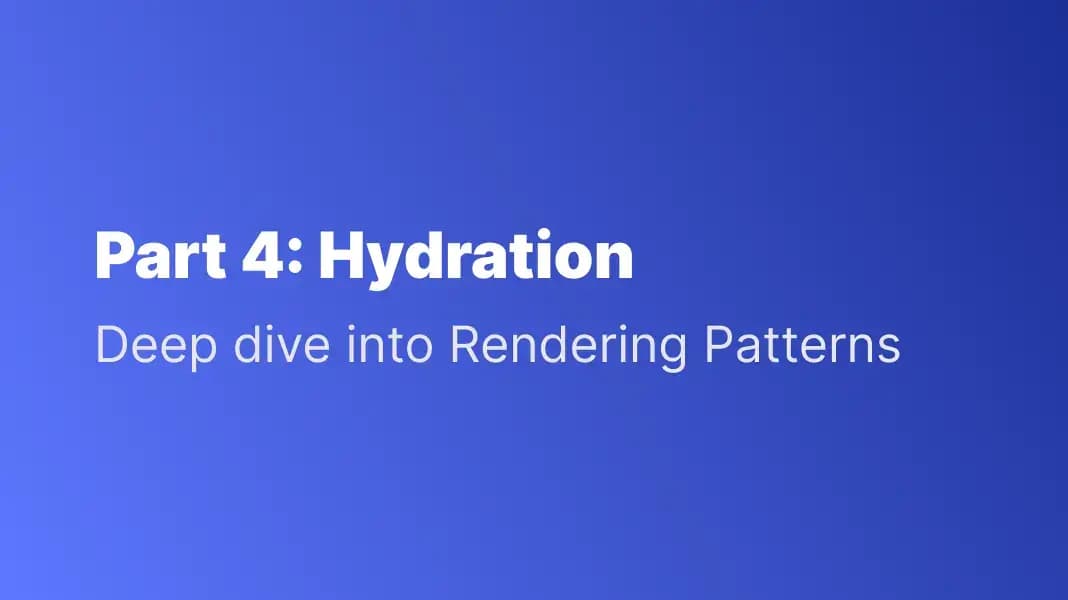user
Hey Chat, could you explain Hydration in simple terms, assuming I have no idea about rendering patterns? 🤔🤔

Hamza Miloud amar
June 13, 2024
4 min read

Welcome back! In our previous post, we discussed Client Side Rendering. Today, we'll explore Hydration, a technique that enhances the performance of Single Page Applications by combining the benefits of Multi page Application and Client Side Rendering. Hydration involves rendering the initial HTML on the server and then hydrating it on the client side with JavaScript to make it interactive.
Web Development Group
Me , Server , Browser, CDN, Narrator
user
Hey Chat, could you explain Hydration in simple terms, assuming I have no idea about rendering patterns? 🤔🤔
narrator
Imagine an artist who creates a black and white sketch. This sketch is like the server rendered HTML sent to the browser. Hydration is when the artist starts to paint over the sketch, adding colors and details to make the drawing vibrant and interactive. This process attaches the necessary JavaScript to the static HTML, enabling interactions and dynamic behavior just like adding colors brings the sketch to life.
user
Mmm, that sounds interesting! Could you explain a real world example, showing the step by step process of how the server and browser work together to make this happen? 🤔
server
OK let me explain! my role as the server is to render your application's components into a fully formed HTML document. This is then transmitted to the browser, ensuring a faster initial page load (Note that hydration, the process of making the page interactive, is handled by the browser, not the server).
browser
Exactly! Once I receive that HTML, I show it to the user right away. But, this initial version is static, kind of like a picture. Hydration is where I come in to make it interactive.
user
So, hydration is what makes the page interactive?
browser
You got it! Hydration is a process that happens on the client side (that's me, the browser!). I run the JavaScript code that came along with the HTML. This code does things like attach event listeners so you can click on buttons, make dynamic updates, and add application state. Basically, it turns a static page into a fully interactive web app.
user
Hmm. How is hydration different from isomorphic rendering?
server
That's a great question. Isomorphic rendering (also called universal rendering) consists of two phases: rendering on the server, which delivers initial content quickly, and client side hydration, which makes the rendered content interactive. this means that hydration is part of the isomorphic rendering.
user
That's much clearer now. Are there any potential issues that can arise during hydration?
browser
Good question! Hydration relies on the server and client being the same. If there are any inconsistencies between the server rendered HTML and what the client side JavaScript expects, it can cause errors.
user
That makes sense. But what's the drawback of hydration?
browser
Slow Time to Interactive: Hydration can slow down how quickly a page becomes interactive (TTI) because the browser needs to download and run all the JavaScript code that makes the page interactive.
browser
Duplicate Execution: The same app logic might need to run twice – first on the server to generate the initial HTML, and then again in the browser during hydration to add interactivity.
user
Ah, I see. Is there a way to solve this problem?
browser
We'll dive deeper into these performance enhancing techniques in our upcoming articles on Progressive Hydration | Island architecture | Server Components , and more. Stay tuned!
user
Thank you for the detailed explanation. I have a much better understanding of hydration and its importance in Isomorphic rendering now.
browser
You're welcome! Feel free to ask if you have any more questions. I'm always here to help!
me
Thanks for taking the time to read my article! I'd love to hear your feedback – any questions, suggestions, or different perspectives are welcome. Your input helps me improve and create even better content. Feel free to follow me and continue the conversation on 𝕏 to continue the discussion.
We hope you now have a better understanding of Hydration and its role in modern web development. Join us next time as we delve into Static Site Generation (SSG), a method that pre-renders pages at build time for optimal performance. Goodbye for now, and see you in our next post on Static Site Generation!
Experienced Frontend Developer | Passionate about building elegant, accessible, and UX-friendly Design Systems with React | Skilled in React Next Remix | CSS enthusiast | Lover of Clean & Maintainable CSS | Always learning and growing.
Let's ConnectConnect With Me On Social Media
I appreciate your visit to my website. If you find my work interesting and would like to know more about me, please consider following me on social media. Thank you!
© 2025 Hamza Miloud Amar. All Rights Reserved
1375 Views